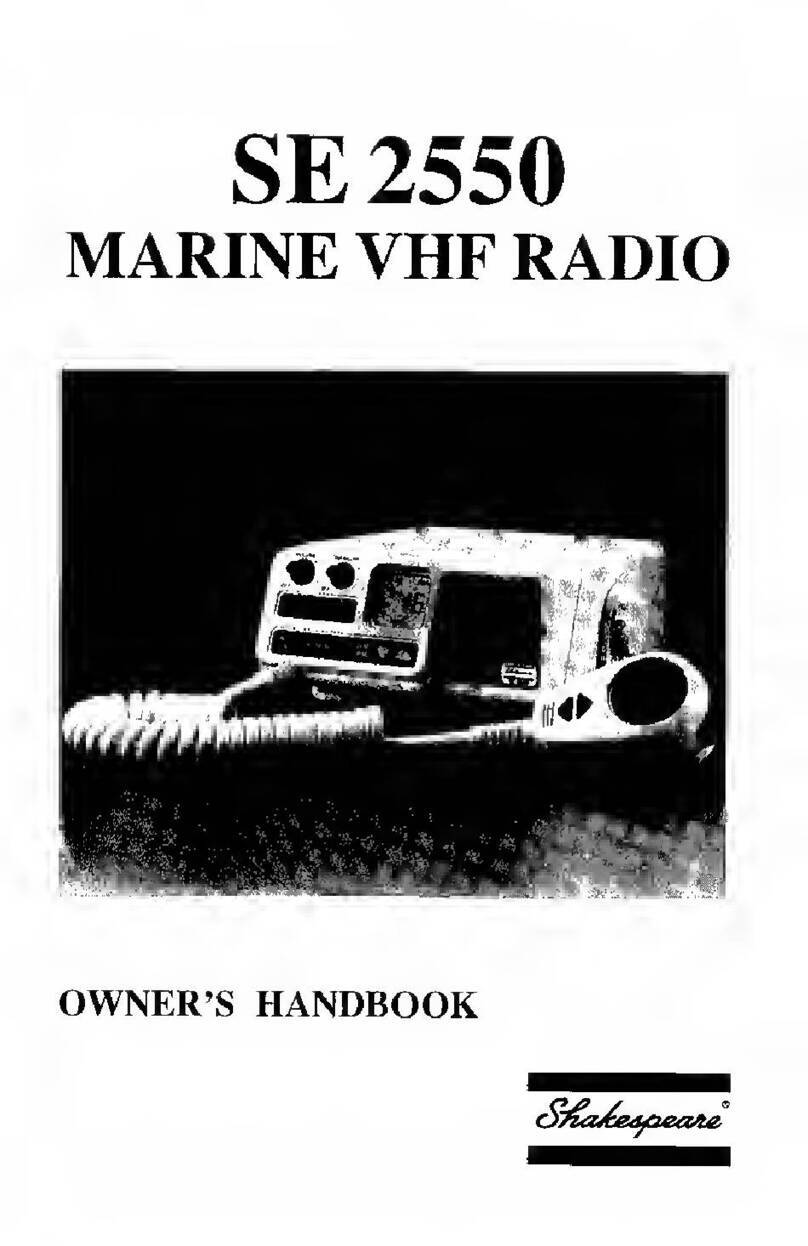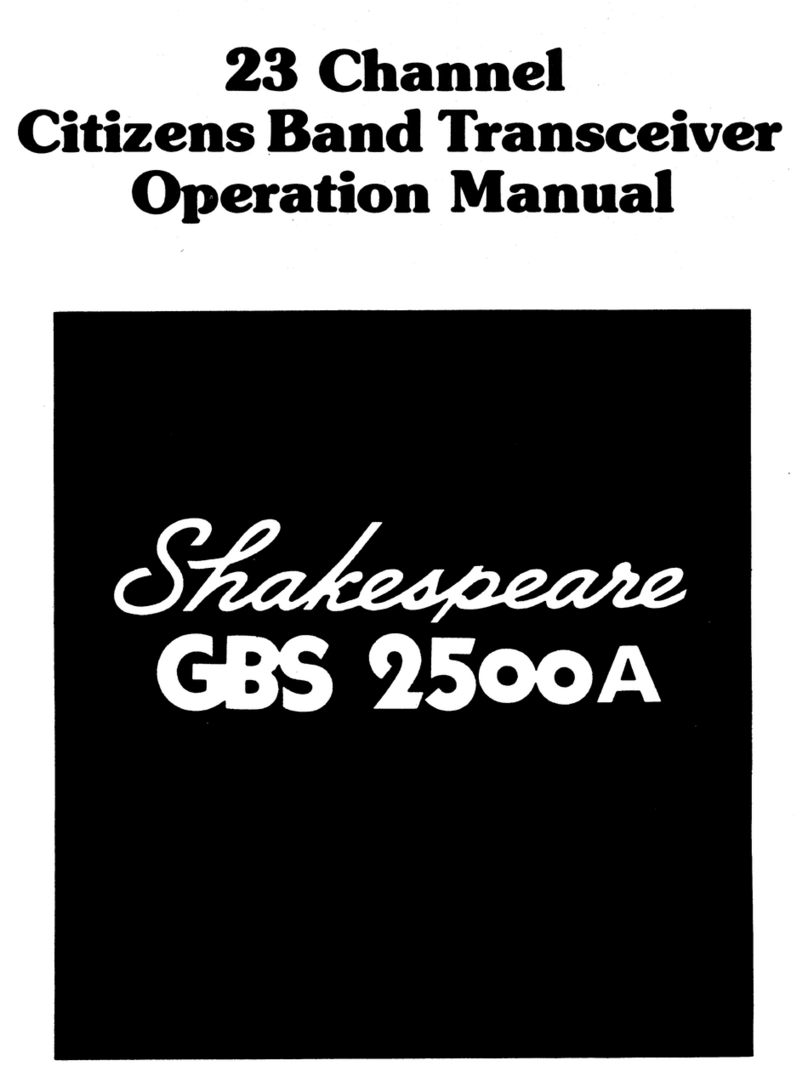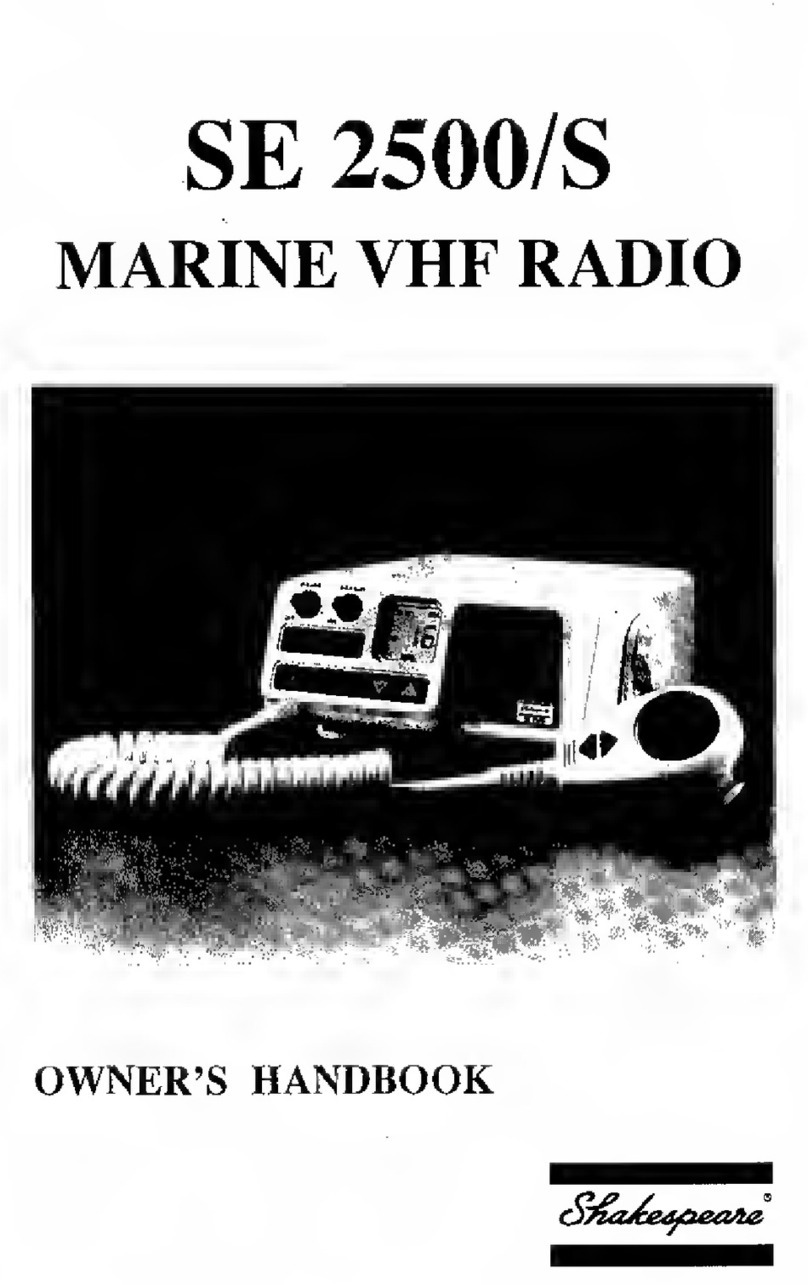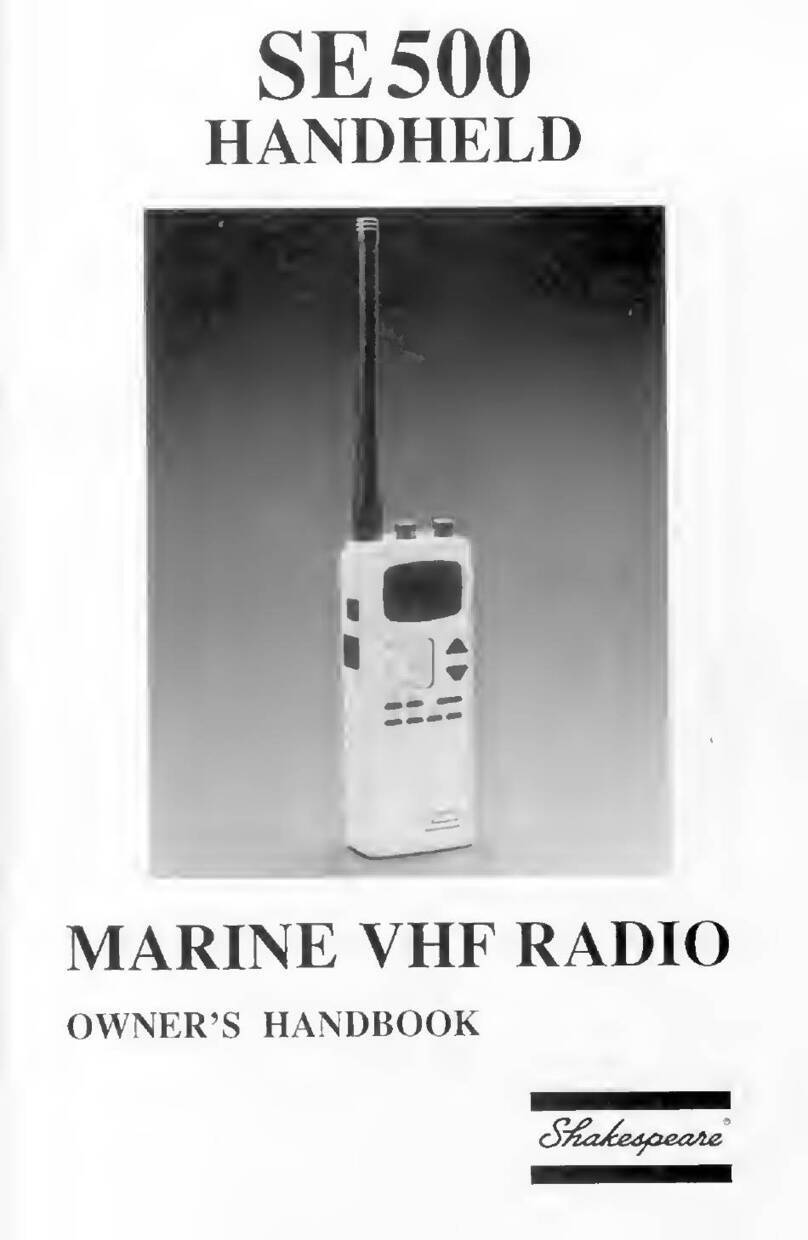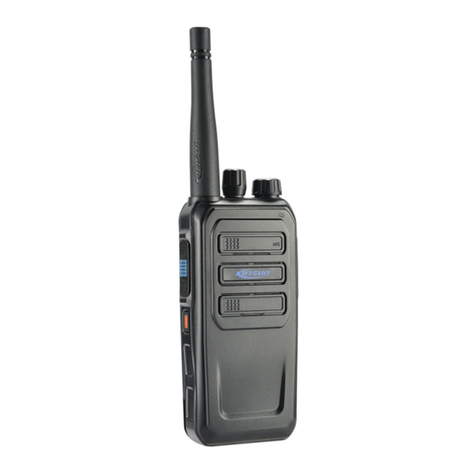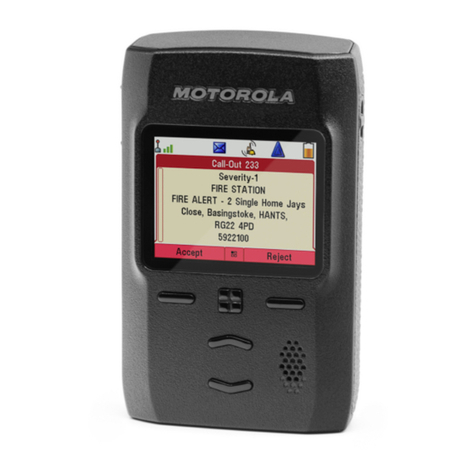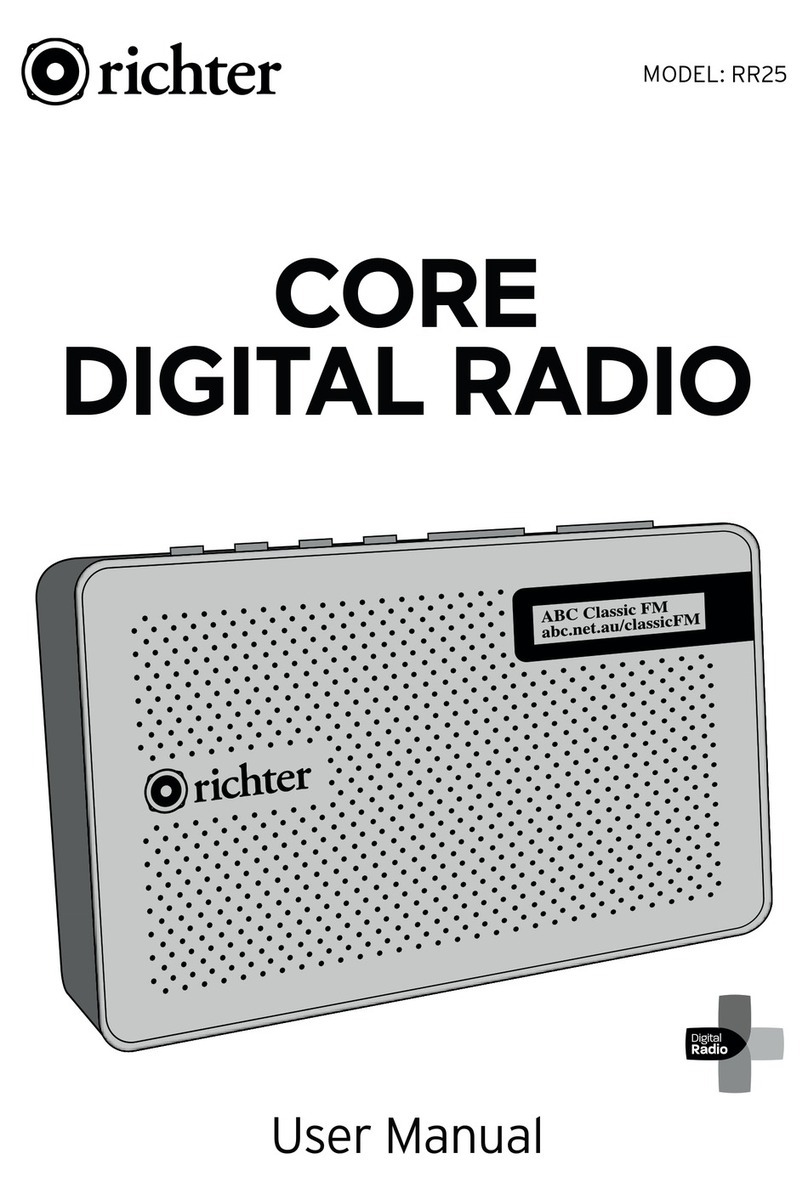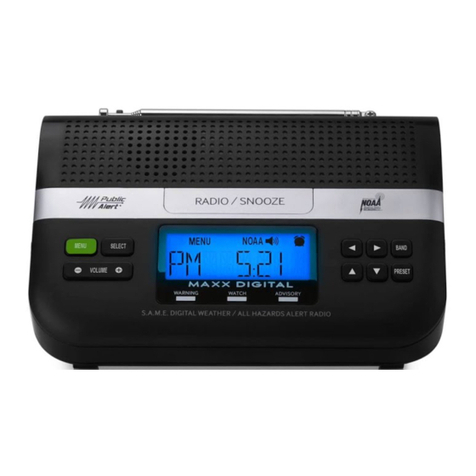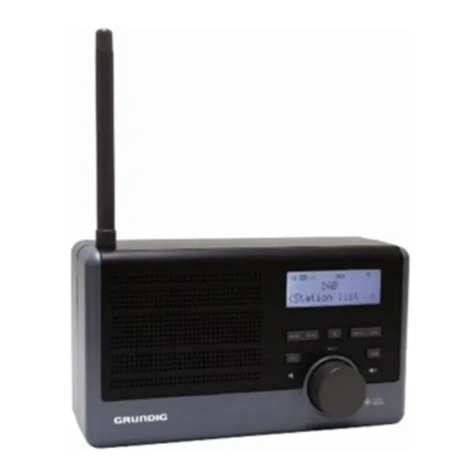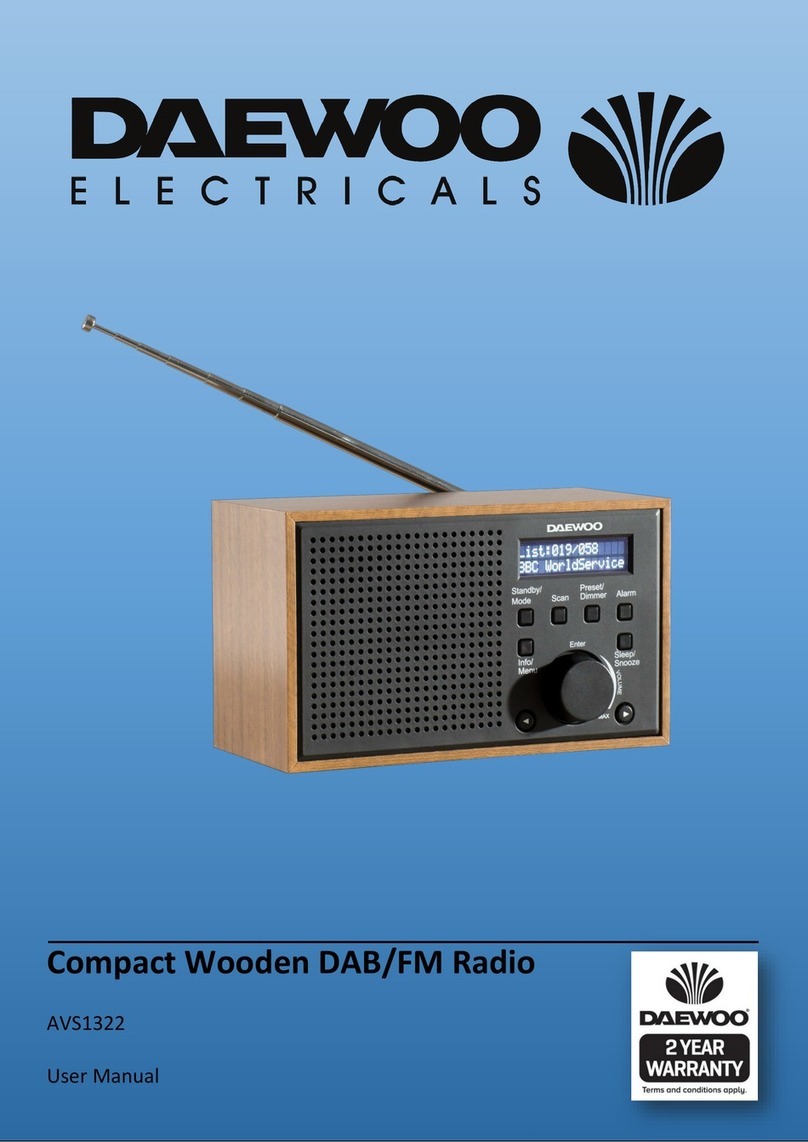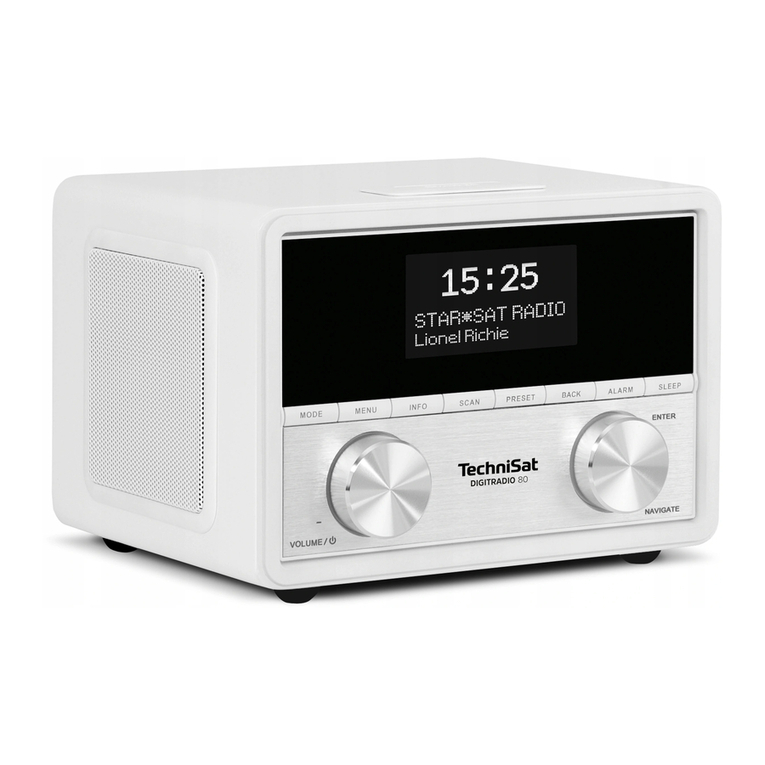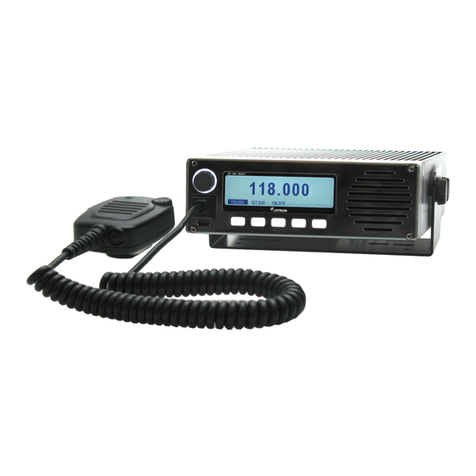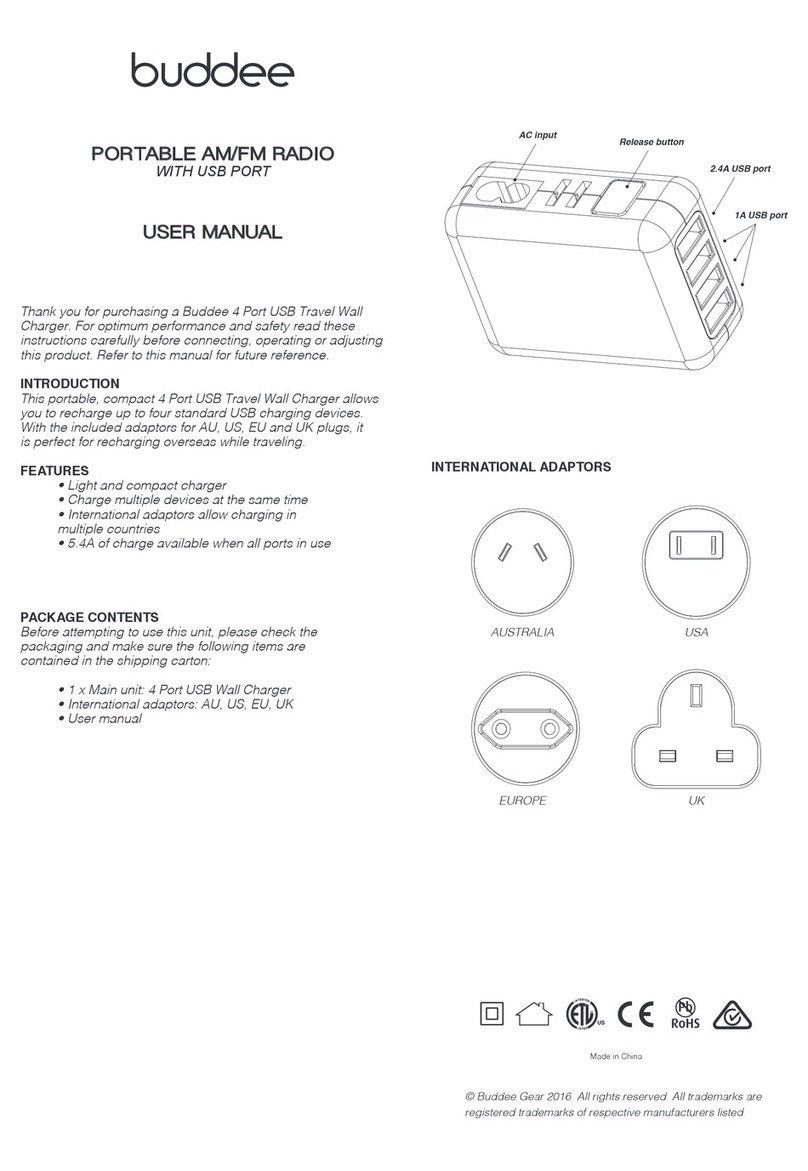Shakespeare Electronic SE 2510 User manual

wm
mm

READ
ME
FIRST
Should
you
encounter
any
problems
with
your
product
DO
NOT
RETURN
THIS
PRODUCT
TO
THE
STORE
•
Please
read
the
manual
carefully.
If
you
still
need
assistance,
call
1-800-800-9008
and
request
Marine
Electronics
Technical
Support.
Before
calling,
get
the
following
information
ready
for
the
Technical
Support
representative.
•
Model
number
•
Serial
number
•
Date
of
purchase
•
Place
of
purchase
•
Your
name
and
address
•
A
daytime
phone
number
•
Describe
the
problem
as
accurately
as
possible
and
tell
the
Technical
Support
representative
what
you
may
have
done
to
try
to
solve
the
problem.
•
The
Technical
Support
representative
will
make
every
effort
to
resolve
the
problem
as
quickly
and
efficiently
as
possible.
KEEP
ALL
PACKING
MATERIAL
AND
CARTON
FOR
FUTURE
TRANSPORTING
_
__
Cutalong
the
line
and
attach
the
section
below
to
the
product
__
In
the
rare
event
you
must
return
this
product
after
talking
with
Technical
Support,
you
MUST
complete
this
form
in
detail
and
place
it
in
the
box
with
the
product.
Model
if:
Serial
ft:
Purchase
Date:
Return
Date:
Owner's
Name:
Home
Phone:
(
)
Address:
Day
Phone:
(
)
Fax:
(
)
Place
of
Purchase:_
Reason
for
Return
(be
specific
-
must
be
filled
out
or
product
will
not
be
accepted)
Cut
along
the
line
and
use
the
section
below
as
your
shipping
label
___
Shakespeare,
Company
Electronics
and
Fiberglass
Division
19845
US
Highway
76
RMA
#
_
Newberry,
SC
29108

TABLE
OF
CONTENTS
1.0
INTRODUCTION.1
1.1
Purpose.1
1.2
Equipment
Description.2
1.3
Brief
Operating
Instructions.3
1.4
Technical
Specifications.6
1.5
Supplied
Parts.7
1.6
License
Requirements.8
1.6.1
License
Application.8
2.0
INSTALLATION
.9
2.1
Unpacking
And
Inspection.9
2.2
Mounting
Preparation.9
2.3
Mounting
Location
Selection....
9
2.4
Unit
Mechanical
Installation.10
2.5
Electrical
Connections.10
2.5.1
Power
Hookup.11
2.5.2
Antenna
Connection.11
2.5.3
Coax
Connector
Assembly.12
2.5.4
External
Speaker
Connection....
13
3.0
OPERATION.14
3.1
Controls
And
Display.14
3.2
Operating
Procedures.15
3.2.1
Power
and
Volume
Control.15
3.2.2
Display
Backlighting.15
3.2.3
Setting
Squelch.15
3.2.4
Channel
Selection.15
3.2.5
USA/lnlemational
Channel
Select.16
3.2.6
Voice
Transmitting.16
3.2.7
High/Low
Transmit
Power.16
3.2.8
Transmitter
5-Minute
TimeOut.17
3.2.9
Weather
Channels
Access.17
3.2.10
Channel
16/9
Priority.17
3.2.11
Channel
13/67
High
Power
Override.17
3.2.12
Dual
Watch
Scanning.18
3.2.13
Master
Reset.18
3.2.14
All
Channel
Scan.18
3.2.15
Memory
Scan.18
3.2.16
External
Speaker.19
3.3
Method
of
Operation.19
4.0
APPENDIX
.
2
0
Appendix
A.20
USA
VHF
Marine
Channel
Assignments
Appendix
B..21
VHF
Marine
Weather
Channel
Assignments
Appendix
C
.
21
International
VHF
Marine
Channel
Assignments
Appendix
D.22
Canadian
VHF
Marine
Channel
Assignments
(Information
Only)
Appendix
E.24
Phonetic
Alphabet
and
Glossary
Appendix
F.25
Block
Diagram
/
PC
Boards

1.0
INTRODUCTION
Welcome
and
congratulations
on
your
purchase
of
the
Shakespeare
SE2510
Marine
VHF
radio.
You
have
purchased
a
high
technology
piece
of
marine
electronics,
certified
waterproof
by
meeting
tough
Coast
Guard
CFR-46
testing
requirements
and
fully
backed
by
the
Shakespeare
name.
The
SE2510
Marine
VHF
radio
incorporates
modem,
compact
styling
and
functionality.
Ease
of
operation
makes
your
boating
communications
totally
professional
and
pleasing.
The
frequency
synthesized
transceiver
provides
access
to
ALL
usable
USA
and
International
Channels,
as
well
as
10
Weather
Channels.
Enhanced
features
like
Channel
16/9
priority,
Weather
Alert,
three
types
of
scanning
modes,
coupled
to
a
large
LCD
display
simply
makes
the
SE2510
the
best
value
in
marine
VHF
radios
on
the
market
today.
The
key
to
obtain
the
most
use
and
pleasure
from
your
new
VHF
radio,
is
reading
the
Owner's
Manual.
This
manual
teaches
you
proper
transceiver
procedures
and
ensure
many
years
of
satisfying
use.
It
is
especially
important
to
cover
the
section
pertaining
to
"License
Requirements"
established
by
the
Federal
Communication
Commission
(FCC).
1.1
Purpose
The
SE2510
Owner's
Manual
is
designed
to
answer
your
questions
about
proper
installation
and
operation
of
your
radio.
Many
new
user
pitfalls
can
be
avoided
by
reading
through
each
section
of
this
manual
before
attempting
to
install
or
operate
your
radio.
The
"Brief
Operating"
section
assures
you
are
on
the
air
quickly
and
properly.
1

1.2
Equipment
Description
The
Shakespeare
SE2510
Marine
VHF
is
one
of
the
smallest,
most
compact
25W
radios
available
in
the
world
today.
The
digitally
frequency
synthesized
transceiver
is
constructed
of
only
the
highest
grade
mechanical
and
solid
state
electronic
components.
Advanced
microprocessor
control,
integrated
RF
circuit
technology,
and
large
high-contrast
LCD
allows
operational
features
not
possible
until
now
in
such
a
compact
unit.
This
full
25W
radio
can
easily
fit
behind
the
steepest
sloped
windshield
or
be
completely
in-dash
mounted
with
the
Shakespeare
optional
Flush
Mount
Kit.
2

13
Brief
Operating
Instructions
Use
the
following
brief
operation
instructions
to
quickly
refresh
your
memory
when
using
the
Shakespeare
SE2510
Marine
VHF
radio.
Please
remember
that
this
section
is
not
designed
to
replace
a
thorough
study
of
the
Owner's
Manual.
1-
Scan
active
indicator
2-
Transmit
active
indicator
3-
Hi
Output
power
indicator
4-
Lo
Output
power
indicator
5-
Memory
channel
indicator
6-
USA
channel
indicator
7-
Intemational
channel
indicator
8-
Weather
Alert
indicator
9-
Weather
channel
indicator
10-
Dual
Watch
active
indicator
11-
Active
channel
readout
12-
Speaker
3
3-Microphone
cable
14-
16/9
Priority
select
key
15-
Scan
&
Memory
select
key
16-
Dual
Watch
&
Transmit
power
select
key
17-
USA/Intemational
channel
&
Weather
mode
select
key
18-
Up
channel
select
key
19-
Down
channel
select
key
20-
On/Off/Volume
knob
21-
Squelch
knob
22-
PTT
(Push-To-Talk)
key
23-
Up
channel
select
key
(MIC)
24-
Down
channel
select
key
(MIC)
3

1.4
Technical
Specifications
General
Compliance:
Waterproofness:
Temperature
Range:
Construction:
Speaker:
Microphone:
Size
(WxHxD):
Weight:
Number
of
Channels:
Channel
Display:
Keypad:
Squelch
Control:
Volume
Control:
Frequency
Control
Method:
Rated
Input
Voltage/Current:
Power
Source
Protection:
Fuse
Rating:
Antenna
Impedance:
Frequency
Stability:
Special
Functions:
Warranty:
TRANSMITTER
Power
Output:
Modulation:
Transmit
Frequencies:
Spurious/Harmonic
Emissions:
FCC
Part
80,
ITU
Radio
Regulations
Appendix
18.
DOC
CATV
RSS-182
Issue
2.
Radio
and
Microphone
Meets
Coast
Guard
CFR-46
Waterproof
Testing
Specifications.
-
20
T;
to
+
50
1;
UV
Stable
Plastic
Front
with
Die-Cast
Aluminum
Rear
Chassis
Sealed
Water
Resistant
Polypropylene
Sealed
with
non-slip
gasketing.
Tactile-Feel
PTT
Switch
and
Silicon
Rubber
UP/DOWN
Channel
change
keys.
Special
styled
internal
electrel
mike
element.
5.6”
x
2.2"
x
4.9".
2
Lbs.
120
Total,
55
USA/55
INT'L
(per
Appendix
18),
10
Wx.
Extra
Large
LCD
with
backlighting.
Silicon
Rubber
Keypad
with
Individual
Tactile-Feel
Switches.
Manual
Knob.
Manual
Knob.
Phased
Locked
Loop
(PLL).
13.8
VDC.
Current
drain
-
5.5Amps
@
25W
&
1.3
Amps
@
1W.
Series
Diode
Reverse
Polarity
Protection.
10A
In-line.
50
n
.
Mates
with
standard
PL-259
connector.
Chassis.
Grounded.
+/-10
PPM
for
both
the
Transmitter/Receiver.
MRU
Memory.
Channel
16/09
Priority
Channel
Selection,
Wx
Alert,
Memory
Scan,
All
Scan,
and
Dual
Watch.
3
Years.
25W/1W
switchable.
16F3
for
100%
156.025Mhz
-
157.425Mhz
@
25Khz
spacing,
55
Channels
total.
43
+
10
Log
l0
(Power)
or
25pW,
whichever
is
Greater.
6

Modulation
Distortion:
Modulation
Limiter:
Frequency
Response:
Hum
&
Noise:
Less
than
10
%
@
IKhz
for
a
+/-3Khz
deviation.
5Khz
deviation
at
100%
modulation
Matching
a
+6dB/Octave
slope
within
+l/-3dB
from
300
to
2500Hz.
Audio
Low
Pass
Filter
is
included.
Less
than
-40dB.
RECEIVER
Receive
Frequencies:
Sensitivity:
Squelch
Range:
Receiver
Current:
IF
Frequencies:
156.025Mhz
-
163.275Mhz
@
25Khz
spacing,
87
Channels
total.
0.30pV
or
less
for
12dB
SINAD.
0.30|iV
to
0.80|iV
@
full
squelch.
.2Amps
in
Standby
1st
IF2l.6Mhz.
2nd
IF
455Khz.
Adjacent
Channel
Selectivity:
Greater
than
-70dB
for
+/-25Khz.
Image
Rejection:
Greater
than
-70dB.
Intermodulation
Spurious
Response:
Greater
than
-70dB.
Noise
Level:
Greater
than
-40dB
unsquelched.
Audio
Frequency
Response:
Matching
a
-6dB/Octave
slope
within
+l/-3dB
from300
to
2500Hz.
Audio
Output
Power:
3W
minimum
@
4
fi
with
less
than
10%
distortion.
External
speaker
works
with
internal
speaker.
Specifications
are
subject
to
change
without
notice
and
are
nominal
unless
otherwise
indicated.
1.5
Supplied
Parts
SE2510
Radio
Transceiver
Mike
Clip
with
screws
Mounting
Knobs
Washers
(2)
Mounting
Bracket
Cable
Assembly
with
fuse
holder
Owner's
Manual
Warranty
Card
FCC
Application-506
7

1.6
License
Requirements
Pleasure
boats
(U.S.
vessels),
equipped
with
a
marine
radio,
must
have
a
Ship
Station
License.
Other
vessels
(including
compulsory
equipped
vessels)
may
require
a
Ship
Radio
Station
License
and
a
Commercial
Radio
Operator’s
License
to
operate
the
radio
station.
If
the
ship
is
not
a
U.S.
vessel,
contact
the
local
authorities
to
determine
licensing
requirements.
When
purchasing
a
new
boat,
you
must
apply
for
a
new
non-transferable
"Ship
Station
License"
from
the
FCC.
Therefore,
upon
the
sale
of
your
boat,
the
FCC
requires
that
you
submit
your
old
license
for
cancellation.
A
change
in
mailing
address
requires
notification
to
be
filed
with
the
FCC.
This
notification
is
mailed
to:
Federal
Communications
Commission
P.O.
Box
1040
Gettysburg,
PA
17326
1.6.1
License
Application
The
Ship
Radio
Station
License
is
obtained
by
filling
out
and
submitting
the
enclosed
Form
506
with
$75.00
to
the
FCC.
DO
NOT
SEND
CASH.
This
fee
currently
covers
a
10-year
period.
If
you
have
any
questions
about
this
fee
or
latest
FCC
rulemaking
updates,
contact
the
FCC
Information
Center
at
1
-800-322-1117
for
details.
To
operate
the
radio
while
waiting
for
the
license
to
be
returned
from
the
FCC,
fill
out
and
keep
enclosed
Form
506A.
This
“Temporary
Permit"
is
valid
for
90
days
from
the
date
Form
506
is
mailed
to
the
FCC.
The
Temporary
Permit
has
instructions
for
assigning
the
vessel's
temporary
call
sign.
The
call
sign
for
your
station
will
be
issued
by
the
FCC
on
your
official
license.
If
the
ship’s
radio
station
is
to
be
operated
in
other
countries,
contact
the
local
authorities
for
their
licensing
requirements.
Mail
Station
License
Application
form
to
:
Federal
Communications
Commission
Marine
Ship
Service
P.O.
Box
358275
Pittsburgh,
PA
15251-5275
8

2.0
INSTALLATION
Before
using
the
Shakespeare
SE2510
Marine
VHF
radio,
please
study
the
following
section.
Failure
to
adhere
to
these
installation
and
operating
considerations
can
damage
or
significantly
degrade
the
performance
of
your
VHF
radio,
as
well
as
void
the
warranty.
2.1
Unpacking
And
Inspection
The
Shakespeare
SE2510
Marine
VHF
radio
comes
to
you
100%
inspected.
When
unpacking,
check
the
parts
shipped
with
the
unit
against
the
supplied
parts
list.
If
there
is
a
discrepancy,
notify
your
selling
agent
or
Shakespeare
Customer
Service
(1-803-276-5504).
If
the
radio
was
damaged
during
shipment,
save
ALL
packing
material
to
make
it
easier
to
file
a
claim
with
the
carrier.
All
damage
claims
from
shipment
must
be
filed
with
the
freight
carrier
used
to
ship
the
radio
to
you
within
10
days.
2.2
Mounting
Preparation
Before
actually
mounting
your
new
SE2510
Marine
VHF
radio,
take
a
little
time
to
read
over
the
installation
instructions.
You
will
find
there
are
many
things
to
take
into
consideration
before
drilling
that
first
hole.
Planning
every
aspect
of
the
installation
first
will
save
time
and
aggravation.
It
will
also
save
money
by
cutting
down
potential
errors
that
require
repair
to
correct.
Before
mounting
begins,
you
will
need
to
purchase
a
marine
VHF
radio
antenna.
Shakespeare
markets
a
full
line
of
high
quality
marine
VHF
radio
antennas
to
fit
every
installation.
The
dealer
you
purchased
this
radio
from
will
be
able
to
help
you
choose
the
antenna
style
best
suited
to
your
type
of
boating.
2
3
Mounting
Location
Selection
The
following
is
a
list
of
items
that
need
advanced
planning
before
selection
of
the
mounting
location.
1.
Find
where
the
vessel’s
+12
volt
supply
and
ground
are
located
and
what
it
will
take
to
get
the
radio
power
cable
assembly
to
it.
2.
Where
can
the
antenna
be
mounted
and
what
must
be
done
to
route
the
antenna
cable
to
the
radio?
_
NOTE
Keep
the
antenna
at
least
3
feet
away
from
the
radio
and
as
high
as
possible
for
best
performance.
_

3.
Where
is
the
best
place
to
mount
the
radio
itself?
Keep
in
mind
that
the
radio
may
be
table
top
mounted,
hang
mounted
overhead,
bulkhead
mounted
vertically,
or
under
counter
mounted.
4.
When
deciding
on
a
mounting
location,
visibility
of
the
front
panel,
access
to
the
front
panel
controls,
access
to
the
mounting
knobs,
room
for
rear
cable
connections
and
access
to
rear
cable
connections
must
be
addressed
and
planned.
2.4
Unit
Mechanical
Installation
Once
a
mounting
location
had
been
chosen,
hold
the
mounting
bracket
at
the
place
where
the
unit
is
to
be
mounted.
Use
the
mounting
bracket
as
a
template
to
mark
the
places
to
drill
holes
for
the
mounting
screws.
To
mount
the
bracket
to
wood
use
stainless
steel
wood
screws.
If
the
unit
is
to
be
mounted
on
fiberglass,
use
stainless
steel
nuts
and
through
bolts
as
the
vibrations
found
on
most
pleasure
boats
will
loosen
self-tapping
screws
mounted
directly
into
fiberglass.
When
the
mounting
bracket
is
secured,
attach
the
SE25I0
to
the
bracket
using
the
mounting
knobs
and
washers
supplied
with
the
unit
The
washers
should
be
inserted
between
the
bracket
and
knobs.
2.5
Electrical
Connections
The
back
panel
of
the
SE2510
comes
with
the
following
standard
connections.
1.
Power/Extemal
Speaker
Cable
2.
Antenna
Connector
(for
PL-259
type
connections)
ANTENNA
CONNECTOR
POWER/EXTERNAL
SPEAKER
OUTPUT
Figure
2-1
Rear
panel
electrical
connections
10

2.5.1
Power
Hookup
The
SE2510
is
supplied
with
a
cable
assembly.
The
cable
assembly
has
4
wires,
Red
(+)
and
Black
(-)
for
power
and
Yellow
(+)
and
Green
(-)
for
an
external
speaker.
The
free
end
of
the
Red
(+)
wire
and
Black
(-)
wire
is
connected
to
the
battery
side
of
the
vessel’s
+12
volt
power
buss.
The
Red
(+)
wire
is
equipped
with
a
10-Amp
special
“Spring”
style
in-line
fuse
holder
for
over-current
protection.
The
Red
(+)
wire
is
connected
to
+12
volt
buss.
The
Black
(-)
wire
is
connected
to
the
Negative
or
Ground
side
of
ship’s
power.
After
the
Red
(+)
and
Black
(-)
wires
are
connected
to
ship’s
power,
plug
the
cable
assembly
into
the
power/extemal
speaker
cable
connector
of
the
radio.
NOTE
Use
at
least
12-gauge
wire
to
carry
the
transmit
5.5-Amp
current.
This
wire
size
is
appropriate
for
up
to
20
feet
of
cable
length.
When
powering
up
the
SE2510
if
no
display
appears
once
the
power
is
turned
on,
check
the
power
cable
hookup
polarity
if
the
in-line
fuse
is
blown.
Remember
to
replace
the
fuse
with
one
of
the
same
10-Amp
rating.
Using
a
fuse
with
higher
rating
can
result
in
permanent
damage
to
the
radio.
To
EXTERNAL
SPEAKER
To
VESSEL’S
POWER
BUSS
Figure
2-2
Power/external
speaker
cable
and
cable
assembly
2.5.2
Antenna
Connection
Plug
the
antenna
cable
PL-259
connector
into
the
connector
on
the
rear
panel
of
the
SE2510
Marine
VHP
radio.
ALWAYS,
screw
down
the
outer
coupling
ring
of
the
connector
to
ensure
a
solid
connection.
11

2.5.3
Coax
Connector
Assembly
BRAID
OVER
ADAPTER
COUPLING
RING
8!»p
5
Slap
9
Figure
2-3.
Coax
Connector
Assembly
1.
Trim
back
outer
jacket
of
coax
back
1-1/8".
2.
Trim
back
the
braided
shield,
13/16".
3.
Trim
back
center
insulation
3/4”.
4.
Slip
coupling
ring
over
cable.
5.
Insert
cable
through
the
middle
of
the
UG-175U
adapter.
6.
Fold
the
braided
shield
back
over
the
end
of
the
UG-175U
adapter.
Be
sure
there
are
no
shield
wires
touching
the
center
conductor.
7.
Screw
the
UG-175U
adapter
into
the
PL-259
connector
while
feeding
the
end
of
the
center
conductor
of
the
cable
through
the
hole
at
the
end
of
the
plug.
8.
Solder
the
center
conductor
of
the
coax
to
the
center
of
the
PL-259
connector.
Trim
center
conductor.
Solder
braided
shield
to
the
PL-259
connector
via
the
small
holes.
9.
Screw
coupling
ring
onto
the
PL-259
connector.
NOTE
If
you
are
not
sure
about
this
procedure,
have
a
qualified
marine
radio
service
technician
assist
you.
12

2.5.4
External
Speaker
Connection
You
can
install
an
externa!
speaker.
The
external
speaker
and
internal
speaker
work
to¬
gether.
Purchasing
and
mounting
of
the
speaker
is
left
to
the
discretion
of
the
owner
as
there
is
a
great
variety
of
external
speakers
available,
but
be
sure
a
4
or
8
ohm
model
capable
of
3
Watts
is
purchased.
Shakespeare
recommends
the
Models
ES-2
or
ES-4
for
use
with
the
SE2510.
The
Yellow
(+)
wire
of
the
cable
assembly
is
connected
to
the
(+)
terminal
of
the
external
speaker.
The
Green
(-)
wire
of
the
cable
assembly
is
connected
to
the
(-)
terminal
of
the
external
speaker
(Refer
to
Figure
2-2).
13

3.0
OPERATION
The
Shakespeare
SE2510
Marine
VHF
radio
was
designed
with
the
marine
environment
in
mind,
with
special
attention
paid
to
ease
of
operation.
The
following
section
is
written
to
help
you
realize
the
maximum
benefit
of
your
purchase.
The
SE2510
Marine
VHF
radio
is
not
only
a
convenience
but
a
valuable
tool
in
life
threatening
situations.
This
life
saving
potential
makes
through
study
of
this
Owner’s
Manual
extremely
important.
3.1
Controls
And
Display
All
controls
and
displayed
information
can
be
found
on
the
front
panel
of
the
SE2510.
The
backlit
LCD
display
shows
selected
channel,
transmit
power
setting,
and
transmit
mode.
The
knob
control
power
ON/OFF,
speaker
volume
adjustment,
selection
of
receive
and
transmit
channels,
transmit
power
level,
squelch
adjustment.
Dual
channel
watch,
weather
channel
access,
USA
or
International
channels
and
instant
channel
16
or
9
priority
select,
Scan
(All
Scan
&
Memory
Scan),
and
Weather
Alert.
A
single
beep
of
the
radio
indicates
a
valid
keyboard
entry.
Three
beeps
mean
an
invalid
entry-PLEASE
TRY
AGAIN.
Figure
3-1
SE2S10
Marine
VHF
Radio
14

3.2
Operating
Procedures
3.2.1
Power
and
Volume
Control
To
apply
power
to
the
SE2510
VHF
radio,
turn
the
Volume
Control
knob
(front
left
control
knob),
clockwise.
A
“click”
is
heard
and
felt.
At
this
point
the
display
shows
numbers
and
annunciators.
The
next
thing
to
do
is
adjust
the
Squelch.
To
do
this,
turn
the
Squelch
Control
knob
counterclockwise
until
static
is
heard
in
the
speaker.
Now,
the
volume
of
the
speaker
can
be
adjusted
to
a
reasonable
level
by
the
Volume
Control.
Make
this
adjustment
by
turning
the
volume
control
back
and
forth
until
you
are
comfortable
with
the
background
Noise
level.
3.2.2
Display
Backlighting
The
backlighting
of
the
display
comes
on
when
the
SE2510
is
powered
up
and
stays
on
for
the
entire
time
that
the
radio
is
on.
There
is
no
brightness
adjustment.
3.2.3
Setting
Squelch
To
adjust
the
squelch
setting,
start
by
turning
the
Squelch
Control
knob
(front
right
control
knob),
all
the
way
counterclockwise.
Rotate
the
Volume
Control
knob
until
the
static
noise
heard
in
the
radio
speaker
is
at
a
comfortable
level.
Next,
when
no
radio
transmissions
are
being
heard,
turn
the
Squelch
Control
knob
clockwise
just
to
the
point
that
the
static
noise
is
no
longer
heard.
This
quiets
the
static
between
received
radio
transmissions
and
still
allows
the
incoming
messages
to
be
heard.
The
level
of
squelch
adjustment
needed
to
quiet
the
radio
static
noise
is
dependent
on
the
background
static
intensity.
Keep
in
mind
that
the
squelch
many
need
to
be
adjusted
when
listening
to
a
different
channel.
3.2.4
Channel
Selection
Channel
selection
for
the
normal
transmit/receive
channels
is
handled
by
two
separate
sets
of
controls.
One
set
of
channel
selection
arrow
keys
is
found
on
the
front
panel
directly
to
the
RIGHT
of
the
LCD
readout.
The
other
set
is
found
on
the
front
of
the
microphone.
The
current
channel
selection
is
viewed
in
the
LCD
display
area.
To
change
channels
using
either
set
of
arrows,
simply
press
channel
B
or
s
arrow
key.
Observe
the
changing
channels
in
the
LCD
display
area.
If
the
channel
displayed
is
a
memory
channel
that
is
stored
in
the
radio's
memory
bank
,
the
“MEM”
annunciator
will
also
be
displayed.
From
your
present
channel
pressing
1^|
arrow
key
will
increase
the
channel
15

numbers.
In
the
same
respect,
from
your
present
channel
pressing
the
0
arrow
key
decreases
the
channel
numbers.
If
the
highest
or
lowest
channel
available
is
reached
and
the
pressing
of
the
arrow
key
is
continued,
the
channel
numbers
will
cycle
around
to
the
top
or
bottom
of
the
list
and
continue
changing.
Holding
the
@
or
a
changes
the
channel
at
a
rapid
rate.
Practice
several
times
to
become
accustomed
to
this.
Some
channels
have
no
TX
function
(Channel
15).
Please
study
the
channel
allocation
list
in
the
Appendix
to
become
familiar
with
the
proper
and
customary
usage.
3.2.5
U
SA/Intemational
Channel
Bank
Select
The
SE2510
is
programmed
to
access
both
United
Stales
and
International
channels.
Which
set
of
channels
you
use
is
determined
by
the
area
of
operation.
Normally
in
U.S;
coastal
areas
and
ports,
the
USA
channels
are
selected.
To
toggle
between
USA
and
International
channels,
press
and
hold
the
WX/INT|
key
for
2
sec.
or
more.
The
channel
bank
selected
is
indicated
in
the
display.
3.2.6
Voice
Transmitting
Until
you
have
memorized
the
proper
usage
of
each
channel,
refer
to
the
Assignment
Appendices
before
attempting
to
make
a
voice
transmission.
There
you
will
find
a
listing
of
the
channels
and
their
usage.
Once
the
proper
channel
has
been
selected,
locate
the
Push-To-Talk
key
on
the
sid
e
of
the
microphone.
The
Push
-To-Ta
lk
key
will
be
referred
to
from
here
on
as
the
j
PI
T
|
key.
To
transmit,
press
and
hold
|
Fir]
for
the
entire
transmission.
While
PTT
is
held
down,
speak
into
the
microphone
slowly
and
clearly.
When
the
transmission
is
complete,
release
the
PI
T
|
key.
While
the
|
PTT
|
key
is
being
held,
‘TX”
appears
in
the
LCD
display
window.
If
the
|
PTT
|
key
is
pressed
for
more
than
5
consecutive
minutes,
the
voice
transmission
is
interru
pted.
“TX”
in
the
LCD
display
disappears
and
the
radio
beeps
until
you
release
the
PTT
[
key.
3.2.7
High/Low
Transmit
Power
The
SE2510
has
two
transmit
power
levels,
1
Watt
and
25
Watts.
The
low
power
level
(1
Watt)
is
provided
for
situations
where
the
two
parties
involved
are
close
to
each
other.
This
reduces
the
congestion
on
the
same
channel
in
areas
far
away,
allowing
more
individuals
to
use
a
channel
at
one
given
time
.
To
toggle
the
power
output
selection
between
“LO”
and
“HI”
press
and
hold
DW/1/25
key
for
2
sec.
or
more.
The
transmit
power
output
level
is
displayed
in
the
LCD
display
window.
16

3.2.8
T
ransmitter
5-Minute
Time
Out
In
the
event
that
the
|PTT|
key
is
held
i
n
for
too
long,
the
transmitter
timer
will
disengage
the
transmit
function
after
5
minutes.
The
|PTT
|
must
be
lifted
and
pressed
again
to
continue
transmission.
This
is
designed
to
prevent
a
channel
from
accidentally
being
tied
up
by
a
malfunctioning
microphone
or
transmitter.
3.2.9
W
eather
Channels
Access
The
SE2510
has
the
ability
to
monitor
National
and
International
weather
service
broadcast.
This
safety
feature
allows
you
to
listen
to
weather
reports
at
any
time
so
changes
can
be
made
in
your
boating
plans.
This
allows
you
to
alert
your
planned
course
and
to
make
shipboard
preparations.
To
chan
ge
from
stan
dard
marine
VHF
channels
to
the
weather
channel
broadcast,
press
and
release
[WX/1NT
key.
"WX"
appears
in
the
LCD
display
indicating
weather
channel
reception.
The
initial
weather
channel
displayed,
is
the
last
one
used.
Use
the
channel
change
arrow
keys
on
the
microphone
or
the
front
panel
to
select
another
weather
channel.
To
exit
the
weather
channel,
press
and
release
|WX/INT
3.2.10
C
hannel
16/9
Priority
As
a
convenience
and
safety
feature,
the
SE2510
VHF
radio
has
a
channel
[16/91
priority
key.
Pressing
this
key
from
any
mode
or
channel
immediately
changes
the
selected
channel
to
channel
16
or
9
with
the
power
output
changed
to
“HI".
Press
and
hold
the
|l6/9|
for
2
sec.
or
more
to
toggle
the
priority
channel.
Channel
16
or
9
is
now
me
morized
and
displayed
each
time
the
|
16/91
key
is
pressed
and
released.
Pressing
116/9
[
key
again
goes
to
the
last
selected
working
channel.
3.2.11
C
hannel
13/67
High
Power
Override
Due
to
the
special
usage,
FCC
assigned
channels
13
and
67
are
restricted
to
1
Watt
under
normal
conditions.
In
some
situations
it
is
acceptable
to
override
t
his
output
le
vel
and
transmit
on
channels
1
3
and
67
at
25
Watts.
To
do
this
,
press
and
hold
the
PW/1/25
key
on
the
front
panel
of
the
radio
at
the
same
time
as
PTT|
is
pressed
for
the
duration
of
the
transmission.
The
LCD
display
shows
“HI”
in
the
display
window
while
the
DW/1/25
key
is
held
down.
Upon
releasing
the
|
DW/1/25|
key,
transmit
output
pow
er
drops
back
to
1
Watt.
When
key
toggles
the
transmit
power
another
marine
VHF
channel
is
selected,
the
setting
between
1
and
25
Watts,
and
does
not
have
to
be
held
in
for
“HI”
power.
DW/1/25
17

3.2.12
D
ual
Watch
Scanning
The
Dual
Watch
feature
allows
you
to
monitor
the
priority
channel
16
or
9,
a
normal
working
channel,
and
the
weather
channel.
Once
the
squelch
is
properly
set,
select
a
working
channel
using
the
chan
nel
select
aiT
Ow
keys
on
the
front
panel
or
front
of
microphone.
Next,
press
and
release
the
DW/l/25
key.
“DW”
is
annunciated
in
the
LCD
display
and
the
scanning
operation
starts.
The
channel
display
then
changes
between
channel
16
or
9
and
the
working
channel
until
a
squelch
break
occurs.
The
channel
displayed
at
the
time
of
the
squelch
break
is
held
in
the
display
for
4
seconds
after
the
end
of
the
squelch
break.
In
case
of
receiving
a
weather
alert
signal
or
the
weather
channel,
the
alert
tone
beeps
for
5
seconds
and
“ALM”
blinks
on
the
LCD.
To
cancel
WX
alert
press
any
other
key.
Pushing
the
|PTT|
key
d
isables
the
Dual
Watch
mode
at
any
time.
Als
o,
pressing
th
e
channel
arrow
keys,
the
channel
[T6/9~|
priority
key,
the
|
WX/INT
|
key
or
the
|DW/1/25~|
key
turns
the
Dual
Watch
mode
OFF.
Any
other
key
press
produces
3
beeps
and
results
in
no
change
in
current
configuration.
3.2.13
Master
Reset
If
you
hold
down
the
|l6/91
key
when
turning
the
power
on,
all
channels
will
be
cleared
from
memory
showing
“CL”
on
the
display,
and
the
weather
channel
will
be
automatically
programmed
to
channel
1.
The
LCD
display
shows
CH16
USA.
3.2.14
All
Channel
Scan
When
a
chann
el
is
selected
without
the
“MEM”
annunciator
showing
and
the
SCAN/MEN
|
key
is
pressed,
the
radio
will
start
scanning
all
channels,
“SCAN"
is
annunciated
in
the
LCD
display.
If
a
signal
is
received,
the
scanning
will
stop
(will
hold
on
displayed
channel)
until
signal
is
no
longer
received
.
Then,
after
4
seco
nds
it
will
co
ntinue
to
scan.
To
cancel
the
scanning,
press
any
key
except
DW/1/25
key
or
|
WX/INT]
key.
3.2.15
Memory
Scan
When
the
mem
orized
channel
is
selected
with
the
“MEM”
annunciator
showing
and
the
SCAN/MEN
key
is
pressed,
the
radio
will
start
scanning
the
memorized
channels.
“MEM”
and
“SCAN”
are
annunciated
in
the
LCD
display.
If
a
signal
is
received,
the
scanning
will
stop
(will
hold
on
displayed
channel)
until
signal
is
no
longer
present.
T
hen,
after
4
s
econds
it
will
continue
to
scan.
To
cancel
the
scanning,
press
any
key
except
|
DW/1/25
key
or
WX/INT
key.
To
put
a
ch
annel
into
memory,
select
an
unmemorized
channel
and
press
and
hold
the
SCAN/MEN
key
for
2
sec.
or
more.
“MEM”
is
now
annunciated
in
the
LCD
display.
18

To
clear
a
memorized
ch
annel,
select
the
channel
to
be
cleared
on
the
display,
then
press
and
hold
the
SCAN/MEN
key
more
than
2
seconds.
“MEM”
disappears
from
the
display.
3.2.16
External
Speaker
When
the
external
speaker
is
connected
to
the
SE2510
the
speaker
on
the
front
panel
is
not
disabled
automatically.
The
volume
is
adjusted
in
the
same
way
as
it
is
for
the
front
panel
speaker
using
the
volume
control
knob.
3.3
Methods
of
Operation
The
marine
VHF
radio
channels
are
becoming
ever
increasingly
crowded.
This
makes
it
very
important
and
every
users
responsibility
to
help
relieve
channel
congestion
through
use
of
professional
radio
techniques.
Following
the
suggested
rules
will
help
everyone
using
marine
VHF.
1.
Before
transmitting,
listen
to
the
channel
for
traffic
already
in
progress.
This
will
stop
you
from
interfering
with
others
using
the
channel
ahead
of
you.
Keep
your
transmissions
as
brief
as
possible
but
still
make
your
message
understood.
2.
Give
distress
calls
PRIORITY
unless
you
are
in
a
position
to
help.
Do
not
transmit
but
continue
to
listen.
3.
If
there
is
no
response
to
your
call,
wait
2
minutes
before
trying
again.
4.
Calls
on
channel
16
should
be
less
than
30
seconds
in
length.
Once
contact
is
established,
switch
to
another
channel
that
is
more
appropriate
for
your
type
of
communication.
Refer
to
the
Appendices
on
channel
assignment
for
the
correct
channels
to
use.
Use
professional
terminology
by
referring
to
the
Glossary
and
the
phonetic
alphabet
found
in
Appendix
E.
WARNING
If
continuous
HI
POWER
radio
transmission
exceeds
4-5
minutes,
do
not
touch
the
rear
Die-Cast
Heatsink.
It
will
be
hot
to
touch.
This
is
expected
normal
operation.
Please
note
that
the
FCC
regulations
require
a
5
minute
transmitter
time-out.
Release
the
radio’s
Push
to
Talk
key
to
reset
the
timer.
19
Other manuals for SE 2510
1
Table of contents
Other Shakespeare Electronic Radio manuals
Popular Radio manuals by other brands
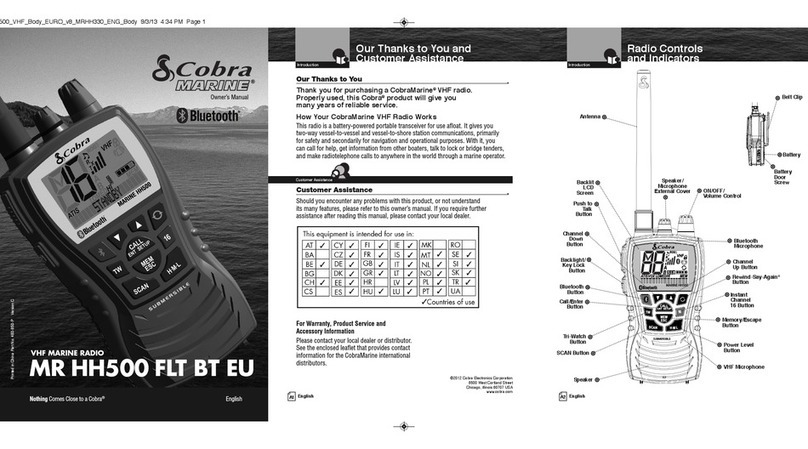
Cobra
Cobra MR HH 500 FLT BT EU owner's manual

Kenwood
Kenwood TK-880 series Programming instructions
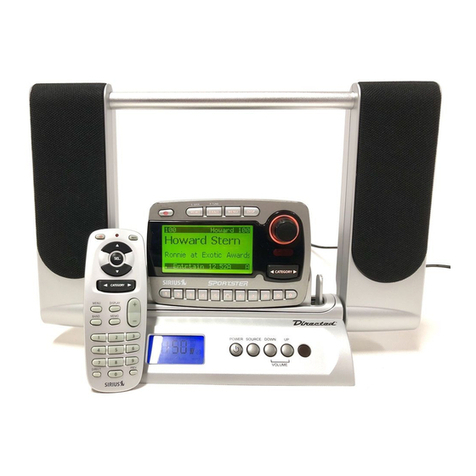
Sirius Satellite Radio
Sirius Satellite Radio Sportster SP-R1 user guide

Craftsman
Craftsman 315.101260 Operator's manual
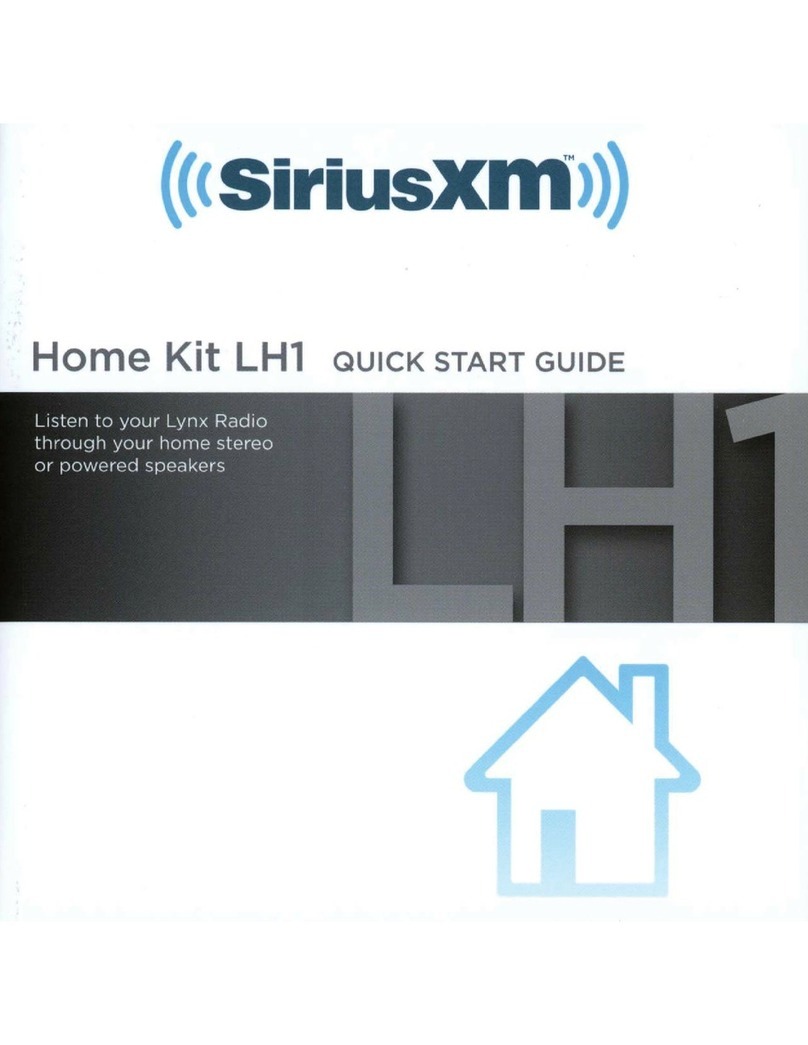
Sirius XM RAdio
Sirius XM RAdio Lynx LH1 quick start guide
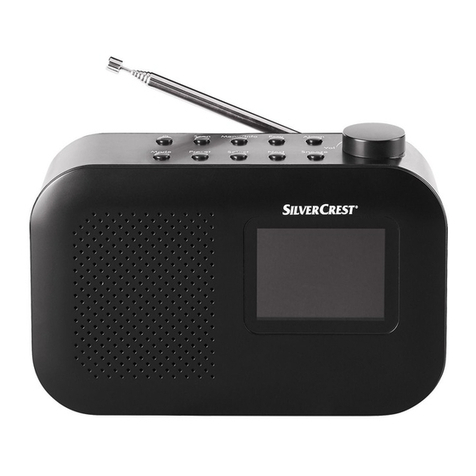
Silvercrest
Silvercrest SDRF 10 B1 Operation and safety notes
